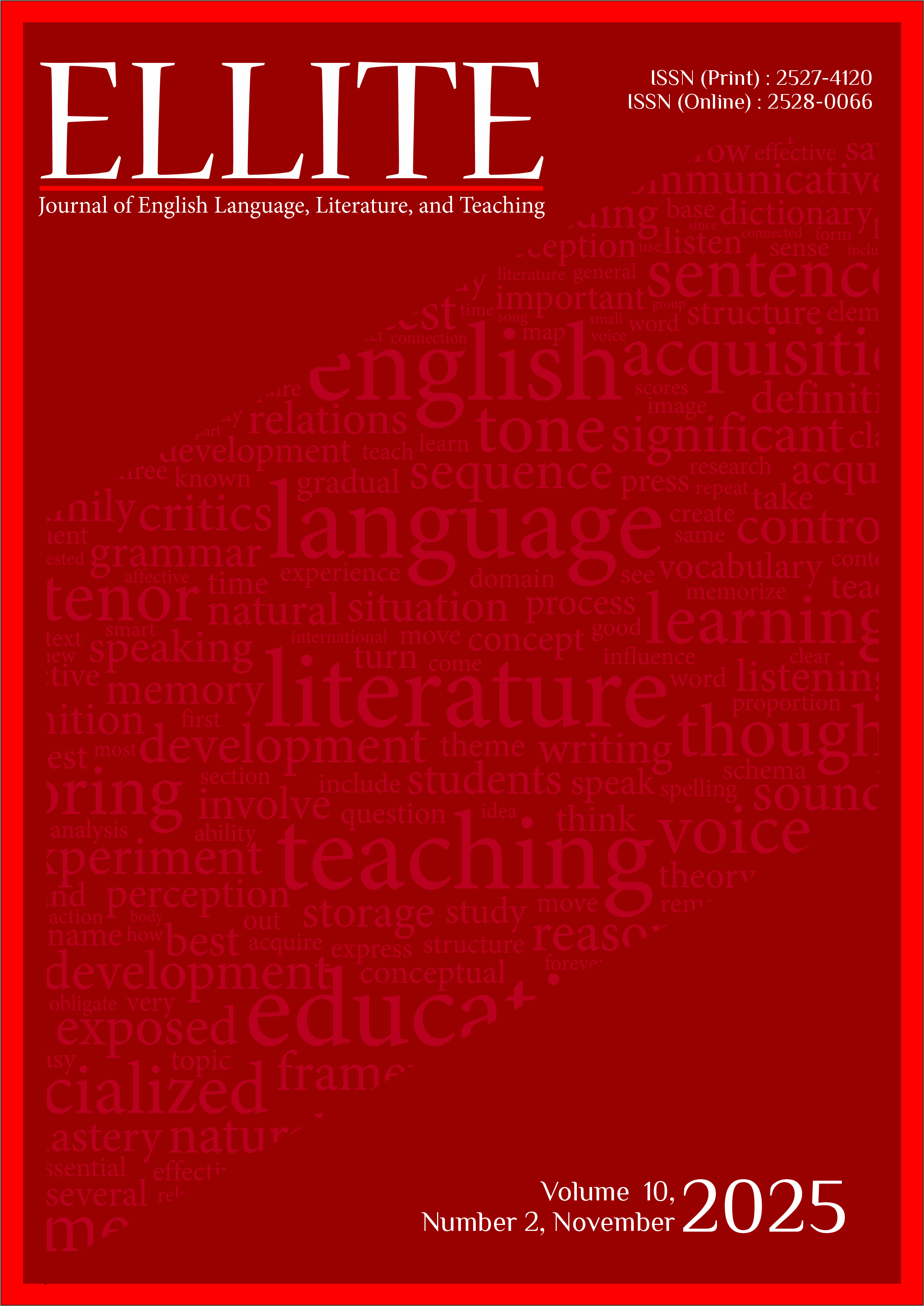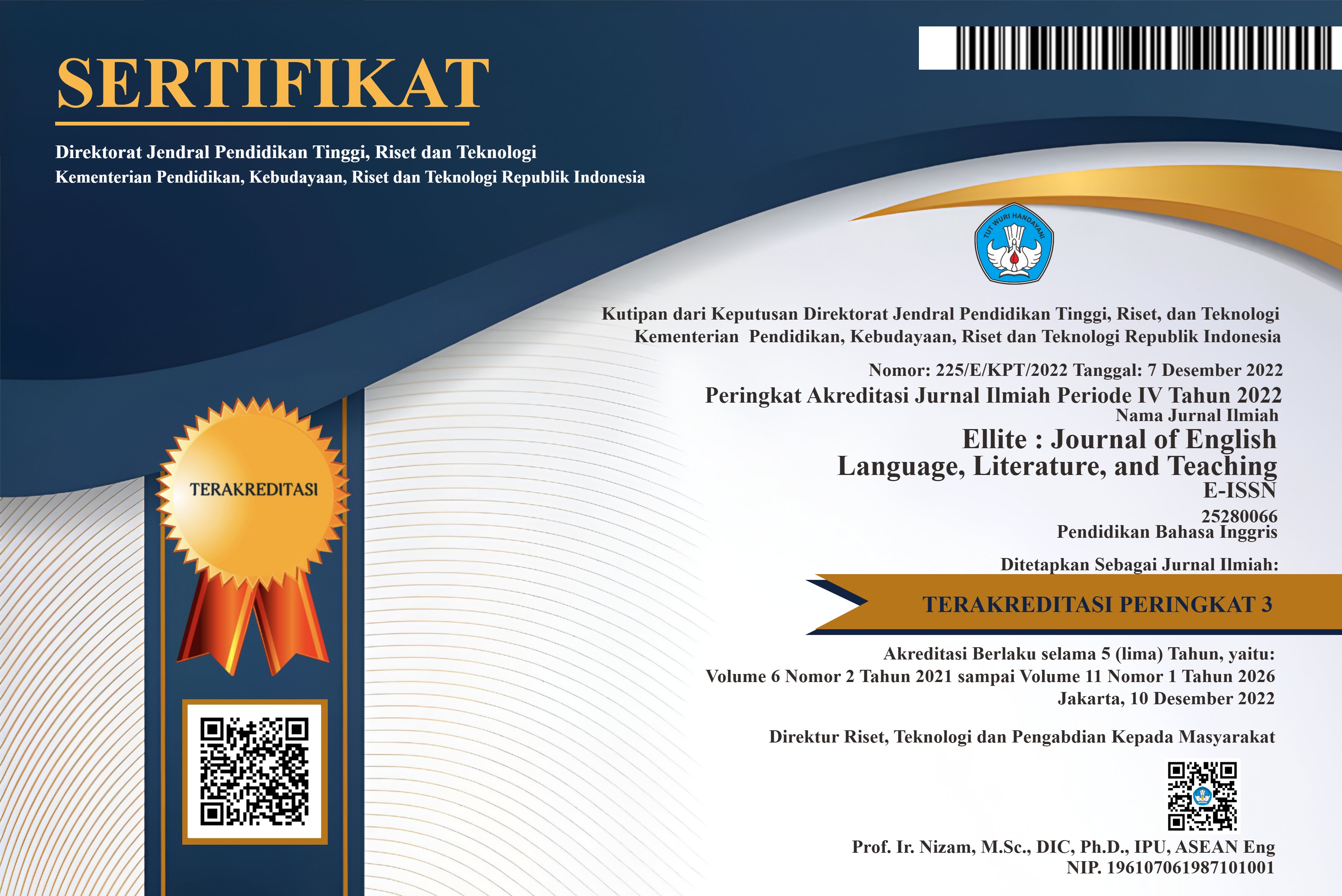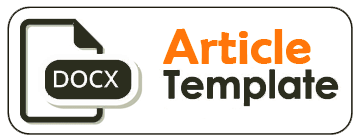Linguistic Landscape of the High-End Culinary Area at GWalk Surabaya, Indonesia in a Multilingual Context
DOI:
https://doi.org/10.32528/ellite.v10i2.4078Keywords:
bilingual, linguistic landscape, multilingual, monolingual, signs, SurabayaAbstract
This study examines the linguistic landscape of GWalk, Surabaya, Indonesia, a region characterized by a rich history of cultural diversity and high multilingualism, particularly in the high-end culinary area, which incorporates influences from Chinese, Javanese, European, and Indonesian cultures. The research collected 201 samples from GWalk using photographs as the primary data source. The analysis reveals multiple dimensions that define the linguistic landscape of high-end culinary spaces. Public signs within the area can be categorized into monolingual, bilingual, and multilingual, reflecting the distribution of languages in the GWalk linguistic landscape. The sociolinguistic aspects of the site highlight the prominence of English as a global language alongside Indonesian. Despite its high-end setting, Indonesian remains the dominant language, coexisting with Chinese, which signifies the dominant ethnic identity in GWalk Citraland, and English represents global connectivity. This interaction among languages offers a promising direction for further research. From an ethnolinguistic perspective, the local language, Javanese, is minimally represented in the linguistic landscape despite efforts to incorporate it through various forms of language modification. These findings underscore the complex dynamics of language use in a socio-culturally diverse and economically stratified urban environment.
References
Andriyanti, E. (2019). Linguistic landscape at Yogyakarta’s senior high schools in multilingual context: Patterns and representation. Indonesian Journal of Applied Linguistics, 9(1), 85–97. https://doi.org/10.17509/ijal.v9i1.13841
Aryani, A. D. (2015). Pedestrian street shopping berkelanjutan sebagai pilihan konsep pengembangan area komersial di Citraland Surabaya. Institut Teknologi Sepuluh Nopember.
Backhaus, P. (2006). Multilingualism in Tokyo: A Look into the Linguistic Landscape. International Journal of Multilingualism, 3(1), 52–66. https://doi.org/10.1080/14790710608668385
Banda, F., & Jimaima, H. (2015). The semiotic ecology of linguistic landscapes in rural Zambia. Journal of Sociolinguistics, 19(5), 643–670. https://doi.org/10.1111/josl.12157
Ben-Rafael, E., Shohamy, E., Hasan Amara, M., & Trumper-Hecht, N. (2006). Linguistic landscape as symbolic construction of the public space: The case of israel. International Journal of Multilingualism, 3(1), 7–30. https://doi.org/10.1080/14790710608668383
Berezkina, M. (2016). Linguistic Landscape and Inhabitants’ Attitudes to Place Names in Multicultural Oslo. In Names and Naming (pp. 120–136). Multilingual Matters. https://doi.org/10.21832/9781783094929-011
Brock, M. N. (1991). The good feeling of fine’: English for ornamental purposes. English Today, 7(2).
Cenoz, J., & Gorter, D. (2008). The linguistic landscape as an additional source of input in second language acquisition. IRAL - International Review of Applied Linguistics in Language Teaching, 46(3). https://doi.org/10.1515/IRAL.2008.012
Ciputra. (2024). Citraland Surabaya. Ciputra.Com.
Curtin, M. (2008). LANGUAGES ON DISPLAY: Indexical Signs, Identities and the Linguistic Landscape of Taipei (1st ed.). Routledge.
Fikriyah, Suhailatul & Wisnu (2013). PERKEMBANGAN KAWASAN REALESTATE DI SURABAYA BARAT TAHUN 1970-2000 (KONTRIBUSI CITRALAND DALAM PERKEMBANGAN KAWASAN REALESTATE DI SURABAYA BARAT). Journal Pendidikan Sejarah (Vol. 1, Issue 3).
Gorter, D. (2006). Linguistic Landscape (D. Gorter, Ed.). Multilingual Matters. https://doi.org/10.21832/9781853599170
Gorter, D. (2013). Linguistic Landscapes in a Multilingual World. Annual Review of Applied Linguistics, 33, 190–212. https://doi.org/10.1017/S0267190513000020
Hallett, R. W., & Quiñones, F. M. (2023). The linguistic landscape of an Urban Hispanic-Serving Institution in the United States. Social Semiotics, 33(3), 645–659. https://doi.org/10.1080/10350330.2021.1916391
Heller, M. (2010). The Commodification of Language. Annual Review of Anthropology, 39, 101–114.
Huebner, T. (2006). Bangkok’s Linguistic Landscapes: Environmental Print, Codemixing and Language Change. In D. Gorter (Ed.), Linguistic Landscape (pp. 31–51). Multilingual Matters. https://doi.org/10.21832/9781853599170-003
Ikmal, N. M., Miskan, & Nailun Najah. (2023). ANALISIS FENOMENA KESENJANGAN EKONOMI KOTA SATELIT CITRALAND SURABAYA DENGAN KAWASAN SEKITARNYA. Prosiding Nasional FISIP Universitas Islam Syekh-Yusuf.
Izzatulfikri, M. F., Khadijah Aufadina, & Saharani Nurlaila Buamonabot. (2018). Surabaya and Symptom of Sarcasm in Food and Beverage Stalls. International Conference on Language Phenomena in Multimodal Communication.
Karam, F. J., Warren, A., Kibler, A. K., & Shweiry, Z. (2020). Beiruti linguistic landscape: an analysis of private store fronts. International Journal of Multilingualism, 17(2), 196–214. https://doi.org/10.1080/14790718.2018.1529178
Lai, M. L. (2013). The linguistic landscape of Hong Kong after the change of sovereignty. International Journal of Multilingualism, 10(3), 251–272. https://doi.org/10.1080/14790718.2012.708036
Landry, R., & Bourhis, R. Y. (1997). Linguistic Landscape and Ethnolinguistic Vitality. Journal of Language and Social Psychology, 16(1), 23–49. https://doi.org/10.1177/0261927X970161002
Lawrence, C. (2012). The Korean English linguistic landscape. World Englishes, 31(1), 70–92. https://doi.org/10.1111/j.1467-971X.2011.01741.x
Leeman, J., & Modan, G. (2009). Commodified language in Chinatown: A contextualized approach to linguistic landscape 1. Journal of Sociolinguistics, 13(3), 332–362. https://doi.org/10.1111/j.1467-9841.2009.00409.x
Lou, J. J. (2017). Linguistic landscape and ethnographic fieldwork. In C. Mallinson, B. Childs, & G. Van Herk (Eds.), Data Collection in Sociolinguistics: Methods and Applications (2nd edition). Routledge.
Lutfiatun, A., Any Novitasari, & Ana Helfiyana. (2018). BAHASA ALAY PADA CHATING DI MEDSOS REMAJA MILLENIAL (BAHASA ALAY VS REMAJA MILLENIAL). Seminar Nasional Bahasa Dan Sastra, 34–41.
Manan, S. A., David, M. K., Dumanig, F. P., & Naqeebullah, K. (2015). Politics, economics and identity: mapping the linguistic landscape of Kuala Lumpur, Malaysia. International Journal of Multilingualism, 12(1), 31–50. https://doi.org/10.1080/14790718.2014.905581
Mubarok, Y., Sudana, D., Nurhuda, Z., & Yanti, D. (2024). Linguistic Landscape in the Tourist Area, Lembang Bandung, Indonesia. World Journal of English Language, 14(2), 230–243. https://doi.org/10.5430/wjel.v14n2p230
Mulyawan, I. W., Paramarta, I. M. S., & Suparwa, I. N. (2022). Language contestation at Batukau Temple, Bali (a linguistic landscape study). Cogent Arts & Humanities, 9(1). https://doi.org/10.1080/23311983.2022.2090651
Nababan, P. W. J. (1986). Sosiolinguistik dan Pengajaran Bahasa dalam PELLBA 2. Lembaga Bahasa Unika Atmajaya.
Pavlenko, A. (2010). Linguistic Landscape of Kyiv, Ukraine: A Diachronic Study. In E. Shohamy, E. Ben-Rafael, & M. Barni (Eds.), Linguistic Landscape in the City (pp. 133–150). Multilingual Matters. https://doi.org/10.21832/9781847692993-010
Rubdy, R. (2013). Hybridity in the Linguistic Landscape: Democratizing English in India. In R. Rubdy & L. Alsagoff (Eds.), TheGlobal-Local Interface and Hybridity (pp. 43–65). Multilingual Matters. https://doi.org/10.21832/9781783090860-004
Shohamy, E. (2015). LL research as expanding language and language policy. Linguistic Landscape. An International Journal, 1(1–2), 152–171. https://doi.org/10.1075/ll.1.1-2.09sho
Spolsky, B. (2020). Linguistic landscape. Linguistic Landscape. An International Journal, 6(1), 2–15. https://doi.org/10.1075/ll.00015.spo
Suwito. (1985). Pengantar Awal Sosiolinguistik Teori dan Praktik. Henary Offset.
Yan, L., & Lee, M. Y. (2014). Tourist Perceptions of the Multi-Linguistic Landscape in Macau. Journal of China Tourism Research, 10(4), 432–447. https://doi.org/10.1080/19388160.2014.953658
Downloads
Published
Issue
Section
Categories
License
Copyright (c) 2025 Rafida Mumtaz, Aura Hilda Haryono

This work is licensed under a Creative Commons Attribution 4.0 International License.







